A complete wildlife garden should provide three things:
1) Shelter
2) Food
3) Water
Where to start
The actual garden plants will provide food and set up the food chains to support animals at higher trophic levels. At some point, you will begin consider the other requirements as well. For shelter and water, see individual categories for information. You have to think about some basic planning considerations. How much space do you have or are prepared to devote to a wildlife garden? You should be realistic because even low maintenance gardens need weeding.
| |
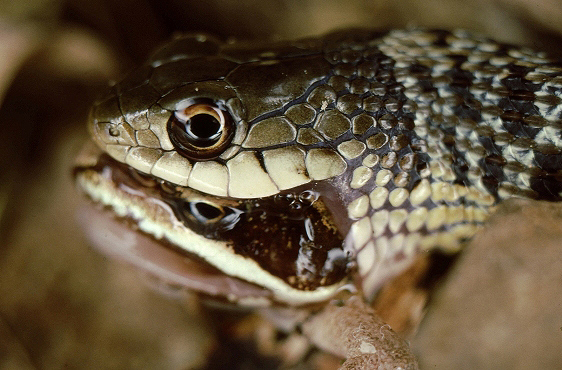 |
|
| |
This was a slow death for the wood frog because the garter snake had some trouble with the legs sticking out. Nature may sometimes be gruesome, but you have to let it take its course to support animals at higher trophic levels. The whole point of a wildlife garden is to give all animals a chance to survive the massive habitat destruction that is occurring. |
|
Type of garden
What type of look do you intend for your wildlife garden? It could be an ornamental garden using native plants, a collection of shrubs and trees, a cottage garden or a completely naturalised garden. The latter type is often the best because it combines low maintenance with high flower density and diversity, thus supporting a greater number of organisms further up the food chain. However, a lot of people have grown up with organised gardens and that is what they think of when you use the word "garden". Naturalised gardens can look messy to your neighbours and they may not understand why it looks like that. When I told my neighbours that I was setting up a wildlife garden, I think they imagined something looking like a jungle! Any type of wildlife garden is helpful.
| |
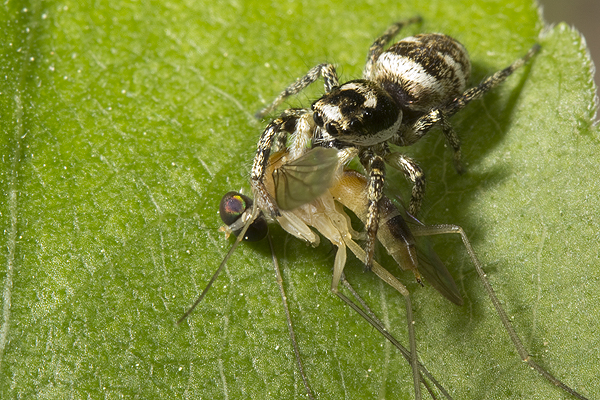 |
|
| |
Any plants you put in a garden are helpful to wildlife because they provide an architecture that invertebrates can use. The plants vastly increase the surface area and the number of nooks and crannies for small animals to live in. This jumping spider, Salticus scenicus, has waited around for a suitable prey. Using its incredible eyesight, it pounces on the mayfly, which is an excellent catch. In sterile gardens, jumping spiders are restricted to walls and fences. In planted gardens, every leaf is a platform. |
|
Where are you going to place your beds?
A sunny location is best because you get the most energy leading to a more productive garden with a higher biodiversity. A wildlife garden in the shade is still possible and it can also look fantastic. Too much sun can present problems because the soil dries out more quickly and the leaves get burnt. Six hours of sunlight is optimal. Beds designed with curved edges look gentler on the eye than straight beds down the edge of the fence. However, even straight beds can look good if your plants are grouped into round patches rather than straight lines. The bed itself should be 4-8 ft deep to allow several layers of plants. Small beds never look good because they lack vertical structure. Remember that for deep beds, you may have to include pathways and access points to reach all your plants. You can stagger the pathways behind plants so that they are harder to see.
Site preparation
If you are converting lawn, site preparation is best done just prior to winter. The grass sod can be cut up and turned over so that any remaining root is exposed and killed by the cold. Converting existing beds is actually harder because you are more likely to have a weed problem. The previous gardener may have left the beds in a state of disrepair which allows weeds to gain a good foothold or they may have planted the beds with plants that aggressively spread and compete for space. The weeds can be manually removed by completely pulling out the root systems. This is hard work. Alternatively, with less weeds, the bed can be covered with 10 sheets of newspaper. The newspaper is soaked and then covered with soil or mulch. Many plants will not grow through the newspaper and will die. Those that do manage to grow through can be pulled. You can punch holes through the newspaper where you want to put your plants. Alternatively, you can use a few layers of cardboard or even a plastic lining. In the spring, it is possible to buy fairly cheaply a lining that will be more permanent than newspaper or cardboard. There are many sites on the internet that cover this subject.
| |
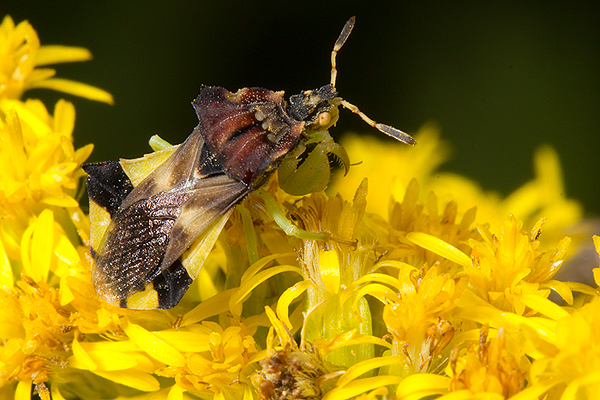 |
|
| |
An ambush bug that lurks in the flowers. They feed on a variety of insects and are common on Goldenrod. |
|
What type of soil do you have and do you need to amend it in any way before planting?
The lowest maintenance gardens have plants that are ecologically suited to the naturally occurring conditions and if you have sandy or clay soils, then your choice of plants can be limited. Plants in sandy soils have to be a lot more drought resistant because the large proportion of soil macropores allows water to flow quickly down the soil profile (See Xeriscaping). Plants in clay soils may have to cope with a lack of oxygen due to poor drainage and a lack of water because soil water movement is restricted. It also takes longer for roots to grow and establish themselves in a soil that is mechanically resistant. On the other hand, clay soils are rich in nutrients and lots of plants do well in them. You can always get your soil tested. This will tell you a lot about the soil and what needs to be done with it.
Look at the colour of your soil. Is it grey? If so, then you are going to have drainage problems. Grey soils result from a lack of oxygen which causes iron to exist in its reduced form. Again, either choose plants that tolerate poor drainage or amend the soil. If your soil is brown, then drainage should not be too bad.
Amending the soil
I would always recommend using the ecological conditions in situ to guide you in your choice of plants because it requires the least amount of work and is the most environmentally friendly option. If you can do this, then skip the following two paragraphs. However, in some areas, the topsoil has been dug up and quite often gardeners do not want their choice of plants dictated to them by their soil type. If that sounds like you, then you can either haul out the soil and replace it or amend the soil that you have. Either process is a lot of work and possibly costly. When I had a garden with clay soil, I carried out a process called double digging. I dug out a trench 16 inches deep and cut 8 inches off the adjoining soil and mixed it with large amounts of composted cow manure. This top 8 inches of soil was used to fill in the first trench. The next 8 inches were placed on top of the first 8 inches and I mixed cow manure into this as well to loosen up the soil. You now have a new 16 inch trench that you can fill in exactly the same way by using the soil from the adjoining land. I continued to do this until all of the bed had been amended. Not only did it help the plants, but it made working with soil a lot less work afterwards. There is lots of information on double digging on the internet.

On a regular basis, you should be adding organic matter to your soil. If you are going to buy something from the store, then composted cow manure is a good option. It does not have high levels of nutrients that can be deleterious to the health of the plants and it is fairly cheap. You can work it in to the top few inches of soil or you can just layer it on top and let the earthworms do the job for you. I prefer to let earthworms do the job because overworking the soil can actually destroy the soil structure and will interfere with the soil ecology (see soil maintenance). If you want free compost, then you can set up a compost pile. When you first cut out your bed, add two inches of compost to your soil to ensure it has enough organic matter. Continuing to do this every year will improve the soil structure and even very sandy or clay soils will start to become excellent media in which to grow plants.
Once you have identified the space, the light conditions, the zone and the soil type, you can start to choose plants. The plant pages on this site have plenty of information about ideal conditions and you can browse through them to get an idea of what is possible. When you buy a plant from a store or online, there is always plenty of information on what conditions are required for the plant to grow well.
| |
|
|
| |
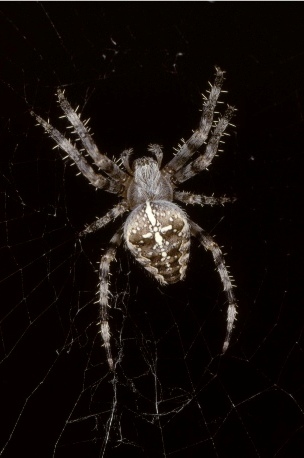 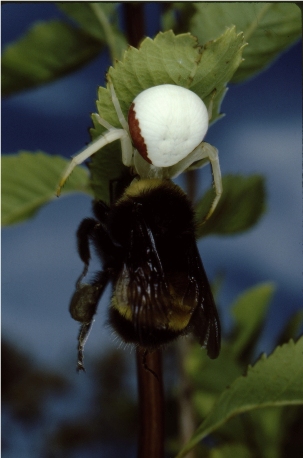 |
|
| |
If you can provide food, then spiders will arrive and prosper in your garden. They provide food for other animals and if they produce webs, then the silk can be harvested by hummingbirds. |
|
Planting design
The unwritten rule is to choose colours on the opposite sides of the colour wheel or to choose closer colours that will form more harmonious combinations. I would suggest not worrying too much about colour in a wildlife garden because the colours of flowers are influenced to a large extent by the type of pollinators they attract. If you want a hummingbird garden, most of your plants will be red and purple. If you want to attract bees or butterflies, most of your plants will be blue and yellow.
You are also supposed to have a 3:2 mix of perennials to annuals. However, if you are only planting native plants then your bed will be probably be completely made up of perennials. Instead of flowering annuals, you could consider clump-forming grasses to plant between your flowers, especially if you are trying to design a dense garden. Planting both will cut down on your weeding and many grasses are hosts for butterflies. If you are using annuals, then you can take advantage of their long flowering season to add plenty of colour to your beds. Pop in the perennials first in round patches spread across the bed and then fill in with the annuals. For ornamental wildlife gardens, it generally is better to have a smaller number of large patches rather than lots of different smaller patches. A plant patch about four feet across works quite well. Larger patches may suffer from problems typical of monocultures. Excess food for one or a few insects encourages a garden to become ecologically unbalanced. Taller plants are placed at the back of the border while plants less than 15 inches should be placed at the front. If your border is an island, then the taller plants go in the middle. If you are mimicking a meadow, then your design may not have patches of plants. Instead, your planting would involve repetitions. Single specimens of perennials or grasses are not that useful to wildlife because they are hard to find and do not generate enough food to support a particular species.
I divide plants according to when they flower. One half of the bed is for the June/July flowering while the other half is for the August/September flowering. This can easily be done if the bed is long and it makes more of an impact.
| |
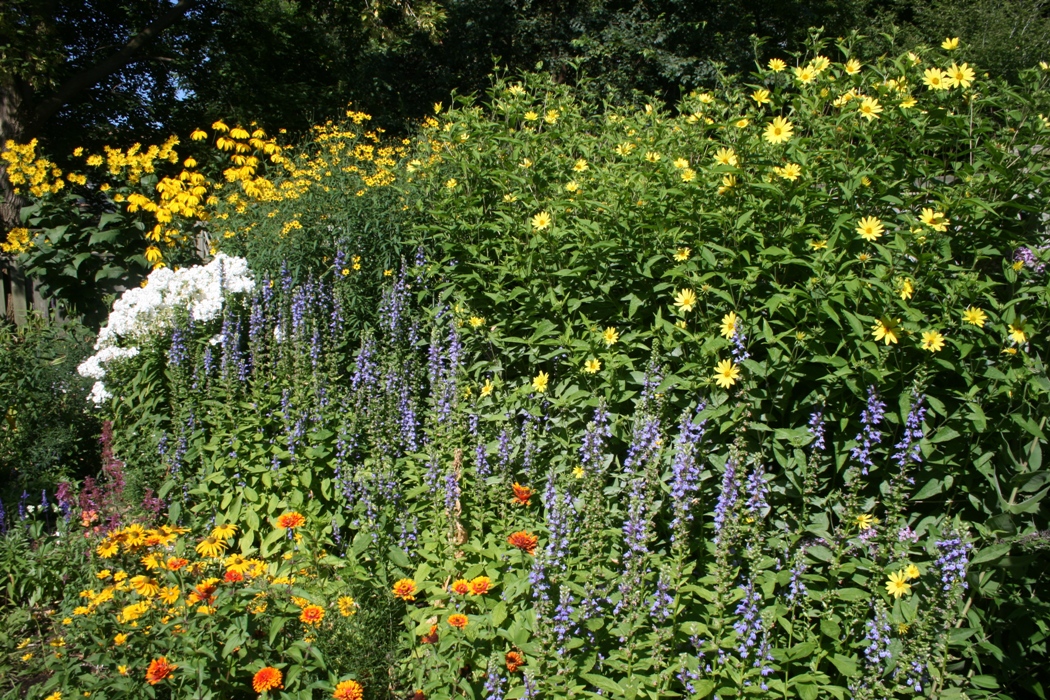 |
|
| |
You may click on the above picture to see a larger image. At the back are plants that get up to 7 feet tall. From the left are Cup Plant, Coneflower, Tall Coreopsis and Perennial Sunflowers. The next layer shows Smooth Aster, White Phlox paniculata, and Great Blue Lobelia. The lower middle layer is made up of some annuals and False Sunflower. There is also another layer of Golden Alexanders and Prairie Smoke, which is not in flower. Because the bed is large, most of the flowers are chosen to bloom at the same time. |
|
It is a good idea to make a scaled diagram. Inevitably, you will probably change your design in the years to come because it is impossible to design beds well with plants that you may not be familiar with. Professional garden designers usually grow test specimens in their own gardens before using them in their work. Changing the position of plants is all part of the fun of running a garden.
| |
 |
|
| |
You may click on the above picture to see a larger image. Choosing plants that flower in the same bloom period can lead to a fantastic and impressive combination of colours that in some way overwhelms the senses. |
|
Choosing plants
On this website, are a large number of suggestions for plants that grow in Ontario, Canada and a large part of the north-eastern and mid-western United States. Plants that grow in Canada are marked with a flag. Avoid planting invasive species which lead to low biodiversity. I have generally not included them on this site except where noted. Native species always lead to higher biodiversity than exotics. We have a large range of fantastic native plants on this continent that would make any garden look like an oasis.
| |
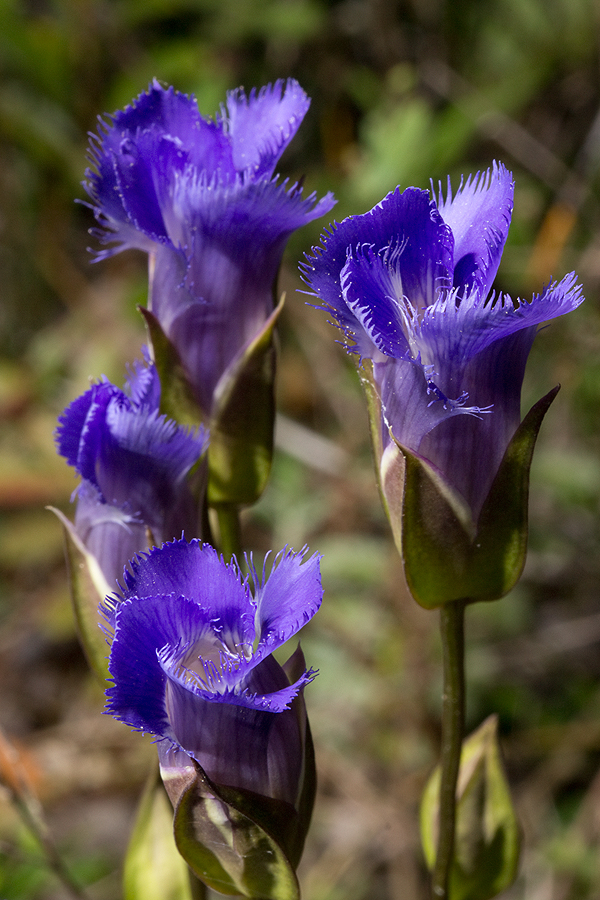 |
|
| |
Fringed gentian is a stunning native plant. Gardeners who dismiss our own native plants as merely weeds are missing out on an opportunity to both cultivate beautiful flowers and help the environment. |
|
What guides your choice is up to you. As a starting point, only choose plants that can survive unaided in your garden. I say this because planting species where they would not ordinarily grow requires more time and maintenance. However, if for example, you want to plant a bunch of moisture loving plants in your dry sandy garden, then group those plants together to make watering and soil amendment more efficient. Planting by water zones is a valid technique as long as you have the time. What are you going to do when you go on holiday?
Other wildlife gardeners plant with a particular type of animal in mind. If you do this, make sure your animal of interest is a typical resident of the area. In general, planting according to colour, height and shape in keeping with the simple principles of garden design will bring in a variety of creatures that will greatly add to the enjoyment of your garden. Most young children will spend a lot of time observing animals in the garden and for many, this initial exposure will start a lifelong appreciation of nature.
| |
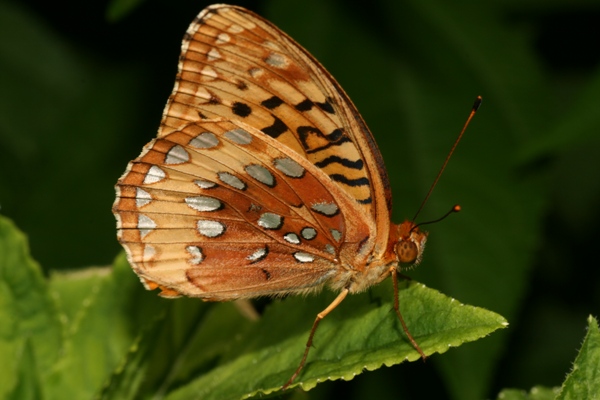 |
|
| |
Over a few years, you will start to notice an increase in the diversity of life in your garden and each year you will see new species. This Great Spangled Fritillary would be considered a desirable species, but even the less desirable ones have a role to play within the ecosystem that you are supporting. This is one of the basic tenets of ecology. |
|
Buying plants
The best place to buy native plants is from specialist native plant nurseries, which mostly adhere to the following principles:
Native plants nurseries do not use harmful pesticides.
Native plant nurseries do not dig up wild plants for selling.
Native plant nurseries either collect their seed from their own stock or collect seed sustainably from wild populations.
Native plant nurseries do not clone plants which increases genetic diversity. Regular nurseries often sell cultivars and nativars.
Native plant nurseries will mostly sell plants native your area and will highlight when they are selling an exotic plant.
Native plant nurseries are often better value for money as they grow the plants themselves, which cuts out the middle-man.
Native plant nurseries are more helpful than regular nurseries because the people who work there have a better knowledge of wild plants.
If you cannot get to a native plant nursery, then ask your local nursery for more native plants. If they get even a few people making such demands, then they will bring them in for sale. When buying plants from regular nurseries, choose cultivars that are similar to the wild species. Avoid fancy cultivars as many of them do not help pollinators. Double flowers are especially problematic since they produce less pollen and less nectar.
First planting
The best time to plant potted plants is in the spring after the last frost. However, many garden plants are sold with a large discount during mid-summer, so if you are on a tight budget, you may want to wait. I plant all the way up to fall, but more care is needed to ensure that the plants survive the first year. In any case, all plants need watering in the first year to get through times of drought. Planting in the fall is also good because with more precipitation and lower air temperatures, you do not have to worry about water stress but you will also have to deal with root-bound plants that did not grow as well. Your plants may also be attacked heavily by pests in the first year. Do not fall into the trap of using pesticides because you will kill off all the natural predators and the food chains needed to maintain biodiversity will never form. Instead, you can use manual techniques such a wiping with a sponge to remove excessive amounts of pests. I found that hardly any interference was needed after the first year because there were enough natural predators around to keep things under control.
| |
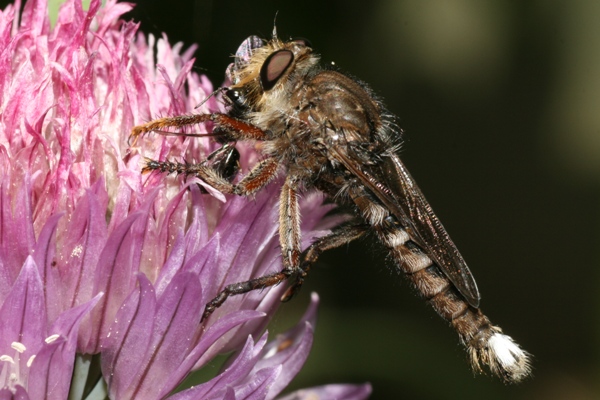 |
|
| |
Robber flies and many other insects rely on plant pests for food. If you spray pesticide, the predator population remains low due to lack of food and you end up in an endless cycle of always needing to apply chemicals that interrupt food chains. |
|
Sowing seeds
If you have large areas to plant and you are working on a budget then seeds are often the most economical way to fill in the garden, but remember, seedlings also require a lot more care in their first year and money will have to be spent on other things such as mulching to keep the weeds at bay while the plants grow. Many seeds will not germinate unless exposed to a period of cold weather. This adaptation allows the plants to germinate when it is getting warmer in the spring rather than in the latter part of autumn. However, not all seeds do this, so the best time to sow the seeds of native plants is just after the first few frosts when the weather is guaranteed to stay cold and prevent premature germination. Many suppliers advise scarifying the seed which usually involves exposing the seed to boiling water or abrading the coat with sand paper. Most seeds do not need this if planted before the hard winter begins. Using fancy indoor seed sewing kits are often a waste of time because your success rate will not be any higher unless you are prepared to use lots of fungicide. Sewing outside is both cheaper and easier. Make a note of where your seeds are as you plant them. Planting from seed requires some patience as it can take a few years or longer for flowering to occur. Even with potted plants, you may have to wait. For example, you may have to wait up to five years for Baptisia to flower. During this time, the plant is investing as much as it can into root development as access to water and minerals is far more important than flowering. For more details see growing plants from seed.



